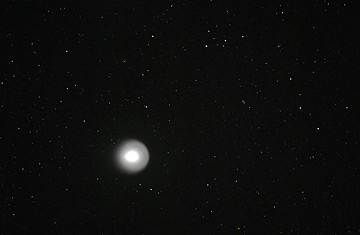
Comet 17P/Holmes as seen through a telescope in Florida.
You wouldn't know it, but billions of comets are lurking right now at the outer edges of the Solar System waiting for their big moment onstage. Most will never get the chance: They're destined to orbit endlessly in the deep freeze of outer space — lonely chunks of dirty ice that will always be far too small to be seen, even with a powerful telescope.
Every so often, though, one is nudged out of orbit by a chance encounter with some other object; it plunges in toward the sun, heats up and releases gases and dust that form a halo and stream away in a long, magnificent tail.
Comet 17P/Holmes is one of the small ones that usually doesn't put on much of a show — or hasn't since it was first discovered in 1892. A couple of weeks ago, however, this insignificant object formed a huge halo (officially known as a coma, from the Latin word for hair), which quickly swelled to the size of the planet Jupiter. And puny Holmes, a million times brighter than it had been a couple of hours before, suddenly became visible to the naked eye. And so it remains: You can see it yourself, without binoculars if you use this NASA website as a guide.
Holmes is nowhere near the sun, so what's causing its outburst? One theory suggests that repeated melting and refreezing of the surface has created a hard crust on the snowball-like comet; heating by the sun has warmed the inside, raising the pressure until the crust cracked and released the pent up vapors with explosive force. The show, say astronomers could go on for several weeks.
